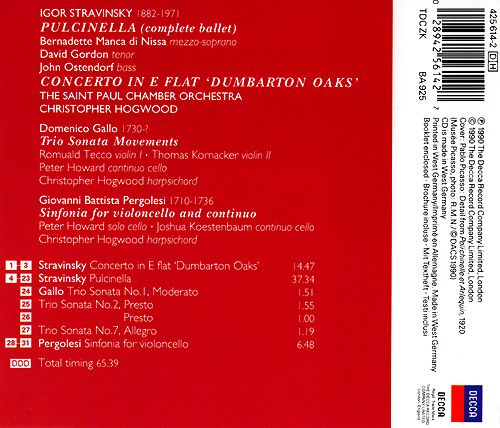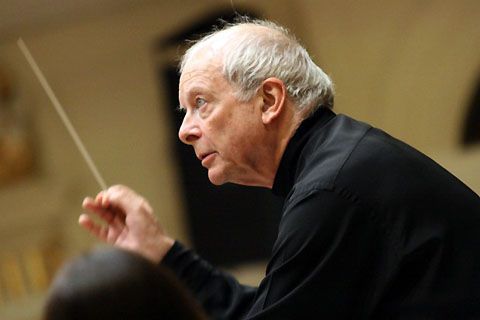wimpel69
11-11-2014, 04:49 PM
EAC-FLAC link below. This is my own rip. Complete artwork,
LOG and CUE files included. Do not share. Buy the original!
Please leave a "Like" or "Thank you" if you enjoyed this!
Before World War I, Serge Diaghilev's Ballets Russes had enjoyed a tremendously rewarding relationship
with Igor Stravinsky, both financially and artistically. In the aftermath of World War I, however,
Stravinsky was struggling to adjust to his exile in Switzerland, and could think of nothing he wanted to
compose or adapt for Diaghilev's use. Enterprisingly, Diaghilev presented Stravinsky with the work of the
Baroque composer Giovanni Battista Pergolesi, with the idea that the composer could adapt the tunes into
a ballet. When Stravinsky proved amenable to the idea, Diaghilev presented him with an old manuscript
of Italian commedia dell'arte episodes featuring a heroine named Pulcinella, and suggested Stravinsky base
the action on one of these stories. To sweeten the deal, Diaghilev assured Stravinsky that no less an artist
than Pablo Picasso would design the sets, and that L�onide Massine, whom Stravinsky respected greatly,
would choreograph. These inducements proved overwhelming, and Stravinsky completed Pulcinella in
1920; its premiere was given that May by the Ballets Russes in Paris, conducted by Ernest Ansermet.
The actual plot Stravinsky chose, involving jealous lovers, mistaken identities, and resuscitating magicians,
is complicated and busy enough that Stravinsky himself admitted that the resulting work as more of an
action dansante than a ballet, although it is subtitled "ballet avec chante" ("ballet with singing"). Stravinsky
chose movements from numerous Pergolesi works (and works perhaps mistakenly ascribed to Pergolesi)
to illustrate the action, and scored them for a small eighteenth century orchestra: no clarinets or
percussion, and concerto and ripenio groups in the strings. Three vocal soloists form part of the
orchestra, without portraying individual characters.
Although he distorted phrases and chord patterns in adapting Pergolesi's music, Stravinsky left much
of the basic melodic and rhythmic content unaltered; Pergolesi, and his stock of bright, engaging melodies,
therefore deserve much of the credit for the success of Pulcinella. But Stravinsky's contribution is equally
engaging: Pulcinella is brilliantly scored, using modern string textures that would not sound out of place
in Bart�k, and engaging combinations like flute, oboe and pizzicato strings or (in an especially witty
moment) trombone and double bass. A sense of carefree play never lets up through the score's bustlings
and scurryings, and Stravinsky takes care to make sure that the instrumentation remains varied, and
that the movements cohere to form a larger formal design. The result sounds characteristic of both
Stravinsky and Pergolesi: eighteenth century music living in a twentieth century world.
While Pulcinella was a success for Diaghilev, it proved even more fruitful for Stravinsky: it eventually
paved the way for his Neo-Classical style. As he was to write later, "Pulcinella was my discovery of
the past, the epiphany through which the whole of my late work became possible. It was a backward
look, of course, but it was a look in the mirror, too."
Considered by some to be a minor work, the Concerto in E flat, "Dumbarton Oaks" for chamber
orchestra is representative of Stravinsky's "neo-Classic" period, which spanned the middle third of
his extraordinarily creative life. The piece was commissioned in 1937 by Mr. And Mrs. Robert Woods
Bliss of Dumbarton Oaks, the name of the Bliss' estate in Washington, D.C., in celebration of the
couple's 30th wedding anniversary in 1938. At the time of the commission, Stravinsky had been
diagnosed with tuberculosis and sent to a Swiss sanatorium to join his wife and two daughters,
who were also ill. Poor health was to claim the lives of his eldest daughter, Ludmila, in 1938, and
his wife, Katerina, in March 1939. While in Switzerland, Stravinsky immersed himself in the music
of Bach while he wrote the Concerto in E flat. Because the composer's illness prevented him from
traveling, the premiere performance, given on May 8, 1938, in Washington D.C., was conducted by
Nadia Boulanger. As in numerous other of Stravinsky's neo-Classical works, he recapitulates forms
and gestures of the Western musical tradition. Thus, the Dumbarton Oaks Concerto self-consciously
becomes didactic music-about-music: an essay on the art of writing a concerto in the Baroque style
realized in modern harmonic, rhythmic, and melodic idioms. Cast in three movements marked
Tempo giusto, Allegretto, and Con moto, the Concerto in E flat deliberately evokes the style of
J.S. Bach's Brandenburg Concertos. The resemblance of the beginning of Stravinsky's concerto
to the first movement of Bach's Brandenburg No. 3 is particularly striking. Concerning this close
relationship, Stravinsky noted, "I do not think that Bach would have begrudged me the loan of
these ideas and materials, as borrowing in this way was something he liked to do himself."

Music Composed by
Igor Stravinsky
Played by
The Saint Paul Chamber Orchestra
With
Bernadette Manca di Nissa (mezzo-soprano)
David Gordon (tenor)
John Ostendorf (bass)
Conducted by
Christopher Hogwood

"Authentic Stravinsky" In more than one sense. Just as he would with Mozart or Handel,
Hogwood has gone back to the sources to provide solutions to a number of textual problems
raised by contradictions between the printed score and the sketches of Dumbarton Oaks
and, in the case of Pulcinella, between the vocal and (revised) orchestral scores.... It is
an extremely enjoyable performance, 'authentically' faithful both to Stravinsky and to
the Italian eighteenth century which was his inspiration... In Dumbarton Oaks the slight
graininess of the string sound, the meticulous care for dynamic gradation, the subtle
colour and internal balances of Stravinsky's very precisely specified chamber scoring all
make for a performance of great elegance, and one in which the Bachian elements are
underlined... A highly desirable coupling, in short."
Gramophone

DOWNLOAD LINK - https://mega.co.nz/#!644kQL6a!z6supVrBGrGdrb4UXA0Vyj4d__H3dWEH5LrFXXV 1XG4
Source: Decca CD, 1990 (my rip!)
Format: FLAC(RAR), DDD Stereo, Level: -5
File Size: 316 MB (incl. artwork, booklet, log & cue)
Enjoy! Don't share! Buy the origina! Please leave a "Like" or "Thank you" if you enjoyed this! :)
LOG and CUE files included. Do not share. Buy the original!
Please leave a "Like" or "Thank you" if you enjoyed this!
Before World War I, Serge Diaghilev's Ballets Russes had enjoyed a tremendously rewarding relationship
with Igor Stravinsky, both financially and artistically. In the aftermath of World War I, however,
Stravinsky was struggling to adjust to his exile in Switzerland, and could think of nothing he wanted to
compose or adapt for Diaghilev's use. Enterprisingly, Diaghilev presented Stravinsky with the work of the
Baroque composer Giovanni Battista Pergolesi, with the idea that the composer could adapt the tunes into
a ballet. When Stravinsky proved amenable to the idea, Diaghilev presented him with an old manuscript
of Italian commedia dell'arte episodes featuring a heroine named Pulcinella, and suggested Stravinsky base
the action on one of these stories. To sweeten the deal, Diaghilev assured Stravinsky that no less an artist
than Pablo Picasso would design the sets, and that L�onide Massine, whom Stravinsky respected greatly,
would choreograph. These inducements proved overwhelming, and Stravinsky completed Pulcinella in
1920; its premiere was given that May by the Ballets Russes in Paris, conducted by Ernest Ansermet.
The actual plot Stravinsky chose, involving jealous lovers, mistaken identities, and resuscitating magicians,
is complicated and busy enough that Stravinsky himself admitted that the resulting work as more of an
action dansante than a ballet, although it is subtitled "ballet avec chante" ("ballet with singing"). Stravinsky
chose movements from numerous Pergolesi works (and works perhaps mistakenly ascribed to Pergolesi)
to illustrate the action, and scored them for a small eighteenth century orchestra: no clarinets or
percussion, and concerto and ripenio groups in the strings. Three vocal soloists form part of the
orchestra, without portraying individual characters.
Although he distorted phrases and chord patterns in adapting Pergolesi's music, Stravinsky left much
of the basic melodic and rhythmic content unaltered; Pergolesi, and his stock of bright, engaging melodies,
therefore deserve much of the credit for the success of Pulcinella. But Stravinsky's contribution is equally
engaging: Pulcinella is brilliantly scored, using modern string textures that would not sound out of place
in Bart�k, and engaging combinations like flute, oboe and pizzicato strings or (in an especially witty
moment) trombone and double bass. A sense of carefree play never lets up through the score's bustlings
and scurryings, and Stravinsky takes care to make sure that the instrumentation remains varied, and
that the movements cohere to form a larger formal design. The result sounds characteristic of both
Stravinsky and Pergolesi: eighteenth century music living in a twentieth century world.
While Pulcinella was a success for Diaghilev, it proved even more fruitful for Stravinsky: it eventually
paved the way for his Neo-Classical style. As he was to write later, "Pulcinella was my discovery of
the past, the epiphany through which the whole of my late work became possible. It was a backward
look, of course, but it was a look in the mirror, too."
Considered by some to be a minor work, the Concerto in E flat, "Dumbarton Oaks" for chamber
orchestra is representative of Stravinsky's "neo-Classic" period, which spanned the middle third of
his extraordinarily creative life. The piece was commissioned in 1937 by Mr. And Mrs. Robert Woods
Bliss of Dumbarton Oaks, the name of the Bliss' estate in Washington, D.C., in celebration of the
couple's 30th wedding anniversary in 1938. At the time of the commission, Stravinsky had been
diagnosed with tuberculosis and sent to a Swiss sanatorium to join his wife and two daughters,
who were also ill. Poor health was to claim the lives of his eldest daughter, Ludmila, in 1938, and
his wife, Katerina, in March 1939. While in Switzerland, Stravinsky immersed himself in the music
of Bach while he wrote the Concerto in E flat. Because the composer's illness prevented him from
traveling, the premiere performance, given on May 8, 1938, in Washington D.C., was conducted by
Nadia Boulanger. As in numerous other of Stravinsky's neo-Classical works, he recapitulates forms
and gestures of the Western musical tradition. Thus, the Dumbarton Oaks Concerto self-consciously
becomes didactic music-about-music: an essay on the art of writing a concerto in the Baroque style
realized in modern harmonic, rhythmic, and melodic idioms. Cast in three movements marked
Tempo giusto, Allegretto, and Con moto, the Concerto in E flat deliberately evokes the style of
J.S. Bach's Brandenburg Concertos. The resemblance of the beginning of Stravinsky's concerto
to the first movement of Bach's Brandenburg No. 3 is particularly striking. Concerning this close
relationship, Stravinsky noted, "I do not think that Bach would have begrudged me the loan of
these ideas and materials, as borrowing in this way was something he liked to do himself."

Music Composed by
Igor Stravinsky
Played by
The Saint Paul Chamber Orchestra
With
Bernadette Manca di Nissa (mezzo-soprano)
David Gordon (tenor)
John Ostendorf (bass)
Conducted by
Christopher Hogwood

"Authentic Stravinsky" In more than one sense. Just as he would with Mozart or Handel,
Hogwood has gone back to the sources to provide solutions to a number of textual problems
raised by contradictions between the printed score and the sketches of Dumbarton Oaks
and, in the case of Pulcinella, between the vocal and (revised) orchestral scores.... It is
an extremely enjoyable performance, 'authentically' faithful both to Stravinsky and to
the Italian eighteenth century which was his inspiration... In Dumbarton Oaks the slight
graininess of the string sound, the meticulous care for dynamic gradation, the subtle
colour and internal balances of Stravinsky's very precisely specified chamber scoring all
make for a performance of great elegance, and one in which the Bachian elements are
underlined... A highly desirable coupling, in short."
Gramophone

DOWNLOAD LINK - https://mega.co.nz/#!644kQL6a!z6supVrBGrGdrb4UXA0Vyj4d__H3dWEH5LrFXXV 1XG4
Source: Decca CD, 1990 (my rip!)
Format: FLAC(RAR), DDD Stereo, Level: -5
File Size: 316 MB (incl. artwork, booklet, log & cue)
Enjoy! Don't share! Buy the origina! Please leave a "Like" or "Thank you" if you enjoyed this! :)